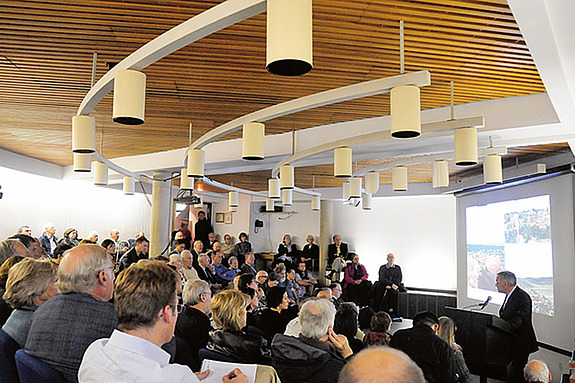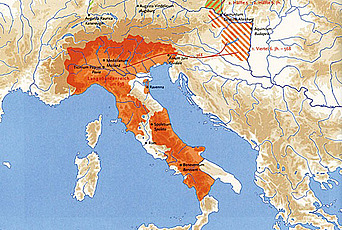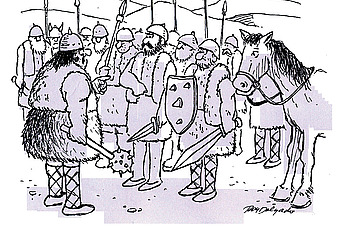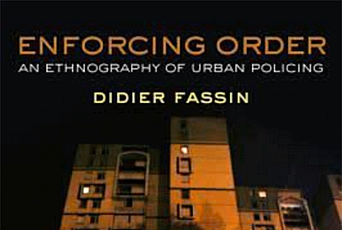DNA, History, and Archaeology

Historians today can hardly answer the question: when does history begin? Traditional boundaries between history, protohistory, and prehistory have been blurred if not completely erased by the rise of concepts such as “Big History” and “macrohistory.” If even the Big Bang is history, connected to human evolution and social development through a chain of geological, biological, and ecological events, then the realm of history, while remaining firmly anthropocentric, becomes all-embracing.
An expanding historical horizon that, from antiquity to recent times, attempts to include places far beyond the sights of literate civilizations and traditional caesuras between a history illuminated by written sources and a prehistory of stone, copper, and pots has forced history and prehistory to coexist in a rather inelegant embrace. Such a blurring of the boundaries between those human pasts that left us more or less vivid and abundant written records, and other pasts, which, on the contrary, are knowable only through the spadework and fieldwork of enterprising archaeologists, ethnographers, and anthropologists, has also changed (or is at least threatening to change) the nature of the work of professional historians.
Technological advances, scientific instrumentation, statistical analyses, and laboratory tests are today producing historical knowledge that aims to find new ways of answering questions that have long exercised specialists of the ancient world. Should historians, then, try to make these pieces of highly technical evidence relevant to their own work? Or should they ignore them? The dilemma is not entirely new. Archaeology, material culture, and historical linguistics have already forced historians to come out of the “comfort zone” of written sources. Archaeologists have by and large wrested themselves free from the fastnesses of the classical texts, and much of their work cannot be regarded as ancillary to the authority of the written word. Satellite photography, remote sensing, archaeo-GIS, C14 dating, dendrochronology (tree-ring dating), and chemical analysis have become standard tools of the archaeologist that coexist with the trowel and the shovel. But the palaeosciences and ancient DNA studies pose challenges of a different order, directly correlated to the greater distance that exists between scientific and historical research in terms of training and knowledge base.
The scientists today engaged in the “archaeosciences” are claiming an independent grip on the past. Specialized journals exude a wealth of information on plants, animals, and climates of the past, ancient pathologies, and the genetic makeup of long-gone peoples. These studies address unresolved questions about humans roaming the earth thousands of years ago, and possibly hold in the balance the solution to theories fiercely debated for decades and even centuries. Identifying the paths and patterns of human migrations and genetic distribution is a high priority.
There are several reasons why such issues remain important, and they are different for different researchers. I started to read ancient-DNA literature because I was interested in a simple question: how did the nomadic peoples of Asia form their empires? The wind-swept, arid, scarcely populated, and technologically backward regions of the central and northern steppe regions of Asia are unlikely places for the rise of powerful political formations. No historian so far has been able to explain satisfactorily the sudden appearance of the first steppe empire created by the Xiongnu (a.k.a. Asiatic Huns) on the doorstep of China in the late third century B.C.E. Its emergence has been thought to have connections with the barbarian invasions that, a few hundred years later, would contribute to the fall of the Rome. Later empires, regimes, and dynasties of steppe origin—Turks, Uighurs, and Mongols—had government institutions, legal systems, religious beliefs, imperial rituals, and a ruling ideology whose first political embodiment can be traced back to the same Xiongnu empire. Considering the whole of world history, who the Xiongnu were and how they became an empire are actually quite important questions.
In order to address these large issues one ought to look into the early history and prehistory of nomadic communities, understand how they lived, moved, adapted, and evolved socially and culturally, and try to figure out how they interacted with other peoples: trade or raid, tribute or conquest. Understanding the genetic legacy of peoples identified as Xiongnu can bear upon how we connect the dots between populations where unusual concentrations of wealth and power or centers of advanced technology may be found. Following genetic traces, one could hope to track the story of steppe nomads, as it were, from rags to riches. But I must admit having been often confronted with a sense of alienation that makes it difficult to assess how to use genetic data. I have the feeling that such evidence is at the same time too much and too little. Relevant studies have been published at an impressive rate in highly respected journals, but the samples from which the ancient DNA information is extracted are minuscule: how relevant are they to population movements across Eurasia over a couple of millennia? Moreover, such data can complicate and often confuse scenarios painstakingly constructed by historians and archaeologists. One might say that may be a good thing: the fresh breath of science can bring a scent of novelty into the stuffy room of historical and archaeological theories. But is that truly so? Only a close analysis can justify that claim, and the risk that this fresh breath may instead be a malicious gust of wind throwing into the air valuable research hypotheses cannot be dismissed in principle.
There is also a more subtle danger. Studies in genetics are highly standardized. First comes the description of the object of the article and of the samples to be examined, followed by an explanation of the laboratory procedure and a technical exposition of the data. The last section typically comprises a discussion of the results and some concluding remarks summarizing the findings in less technical language. Anyone who does not have the necessary scientific training, like me, would have to focus on the beginning and the end of the essay, and take the rest on faith.
Archaeogeneticists do not shy away from making historical statements and often present complex arguments tying genes and history together. Yet an examination of the historical accounts is no idle or simple exercise. Even in the relatively narrow category of articles directly relevant to my research, the level of attention to historical matters varies substantially. If the “knowledge” that informs the definition and description of historical populations, or events such as conquests and migrations, or even the bare chronology, is superficial or wrong, can the scientific results obtained through DNA tests still be useful? Let’s ask this question differently: assuming that all the scientific tests are exactly right, how are we going to use the results if there is no clear understanding of how ancient societies might have functioned in terms of migration, marriage, culturally or politically controlled reproduction, and social stratification?
Stripped down to their scientific essence, the laboratory results are of scarce utility. They require, in order to be useful, a historical and archaeological context, and therefore one could say that testing the adequacy of the historical assumptions and conclusions is just as important as making sure that the tests are done correctly. Let me give a concrete example. Often we read that a particular individual whose DNA is being extracted and tested was a “nomad” or a “Xiongnu” when dealing with samples coming from Iron Age sites in Mongolia, northern China, or Kazakhstan. Yet there is no evidence to associate the individual whose genes we are looking at with an identifiable Xiongnu population or even with “nomads.” These categories are highly problematic to begin with, and once the genetic results are classified as such (Xiongnu or nomad) we only add to the difficulty of unraveling an already convoluted and confusing picture.
A recent article (2006) presented the test results of samples of ancient human DNA from the site of Egyin Gol, an Iron Age necropolis in northern Mongolia, conventionally dated by archaeologists between the third century B.C.E. and the fourth or fifth century C.E. The site has been attributed to the Xiongnu culture, and the inhabitants regarded as Xiongnu. The authors surmise that some events must have happened there, since “for many centuries, the Baikal region was a contact zone between Siberian and Central Asian tribes, and significant ethnic events occurred (e.g., wars, territorial conquests, and population movements).” They also state: “the formation and development of the Mongolian population was thus a complex process affected by the mixture of ethnically different people,” and finally conclude, “given that the cultural differences which occurred since the fourth century B.C. were important, especially from the Xiongnu empire (third century B.C.–second century A.D.) to the Mongolian one (twelfth century A.D.), it is likely that the impact of the succession of Turkic and Mongolian confederations on the territory of the current Mongolia was a cultural or linguistic process rather than a migratory or genetic one.” One is at a loss to make sense of these conclusions, which essentially restate what historians have taken for granted for a very long time. What the genetic tests tell us, as described by the researchers, is that (1) the people whose DNA was extracted were quite close to the present-day population of Mongolia, and (2) the maternal lineages have a different pattern of distribution with respect to paternal ones. To go from these two pieces of information, in themselves quite valuable, to the historical conclusions stated in the article requires a leap that is both unnecessary and unfounded. If we use a known (or presumed known) historical picture to explain a given result, how does genetics contribute to modify and increase historical knowledge? New results should be used first and foremost to generate new research hypotheses.
The tendency to explain the distribution of genes according to assumed patterns of behavior of certain peoples and societies is quite common in ancient DNA studies. Ultimately, these assumptions go back to historical, anthropological, and archaeological models, and sometimes not the best of them. Inevitably one runs the risk of ending up with conclusions that not only accept as given the existing historical narratives, but may confirm particularly poor versions of them. Going back to the Xiongnu, I am surprised that they are taken often as an ancient population in their own right, or, in the best of cases, that variations in the genetic composition of people assumed to be Xiongnu are attributed to the existence of multiple sets of populations within a large empire, to the effects of Xiongnu conquests and subsequent mixing with a great variety of people, or even to what some have defined as “racial toleration” within their empire. In reality, in every case I have seen, the evidence that shows for certain that the people examined were “Xiongnu” (whatever that may mean) or belonged to any empire is next to nil. To attribute genetic admixture to readymade historical notions of political expansion and conquest means also that scenarios built as hypotheses by historians and archaeologists are never going to be questioned.
My concern with the way in which geneticists access and deploy historical arguments leads me to another consideration. That DNA evidence can provide clues to unrecorded historical events is surely one of the key potential uses of ancient DNA, but how can we make sure that such a clue is historically meaningful? If ancient DNA can lead to the discovery or even the solution of unknown human events—migration, war, settlement, enslavement, conquest, etc.—it is necessary to make sure that genetic data is interpreted according to scenarios that make sense historically and archaeologically, and often this requires first of all a greater sensitivity toward what we may call the “identity” of an excavated site. Secondly, a certain acquaintance with how ancient populations may have been structured socially, ethnically, and politically is required. It makes a difference if what we regard as an intrusive genetic element appears in a common tomb or in an elaborate elite burial. In other words, the categories used by historians, archaeologists, and anthropologists when they examine ancient remains can be complicated and may not be easily transferred to a biological context.
I believe that historians, especially those working in areas for which written records are nonexistent, ought to be taking seriously the evidence churned out by genetic laboratories. On the other hand, geneticists must realize that the effectiveness of their research is limited unless they access reliable historical information and understand how a historical argument may or may not explain the genetic data. What historians bring to the table depends on how “testable” their historical hypotheses are. To give an example again based on our Xiongnu problem, if DNA research could help form a picture of the genetic distribution in various regions that are regarded as the homeland of early nomads—northern China, Mongolia, Tuva, Transbaikalia, etc.—this would be in itself a great advance, but since this is, in practice, impossible, one might seek to identify those sites that are most promising. Based on what I have been able to cobble together from existing studies, it would be interesting to see whether patterns of genetic distribution may correlate with advanced technology (for instance metallurgy), with centers of political power, and with early trade routes. Such a rough and unsophisticated hypothesis may be a starting point for a cooperative project between historians, archaeologists, and geneticists. Any result in that direction would take us one step forward in our understanding of large cultural and demographic events in central, northern, and east Asia, and of the fateful genesis of ancient nomadic empires.


